Advance publication in Germany’s largest tabloid newspaper as well as other media buying in on this have created a bona fide hysteria. There are, of course, tons of cartoons on Sarrazin. They can be found here. Let me just point out this one by Harm Bengen, as well as the Turkish translation.
On Thursday Israel and Palestine began new talks after almost two years of silence. Unsurprisingly, toonpool.com artists are far from convinced that there will be a positive outcome. There’s pessimism about the chances for peace, concerns about both sides’ destructive policies, about the complexity of the process, about America’s neutrality, as well as the cynical conviction that the whole peace process is – as one famous admiral once put it - “a trap”. This last cartoon is probably the most positive statement.
Cartoons of Interest
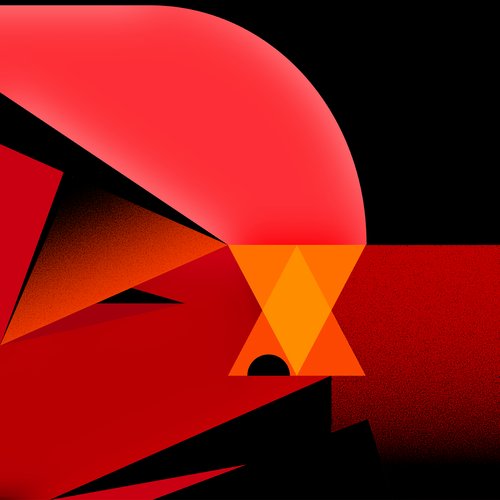 Michele Rocchetti’s stylized caricature of Vladimir Ilyich Lenin is (in my opinion) the most stunning cartoon uploaded last week. As one user writes, it may take some time and meditation until you get it. It’s worth it.
Michele Rocchetti’s stylized caricature of Vladimir Ilyich Lenin is (in my opinion) the most stunning cartoon uploaded last week. As one user writes, it may take some time and meditation until you get it. It’s worth it.
Other great cartoons include these two about inventiveness, these two about preparedness, and a cross-hatched caricature of Michael Douglas. While I don’t really like his films (except maybe Romancing the Stone) I do hope that everything works out fine for him, cancer-wise.
]]>On Monday morning, Israeli forces boarded the ships of the “Gaza Freedom Flotilla” headed for the coast of Gaza. It’s no use to describe the events in detail here, you very likely read about them anyway. Nine of the ships’ passengers were killed. The majority of artists commenting on the events joined the international protests against Israel’s actions. Here’s three examples: a gunship versus a bread-ship, Israelis as bloody pirates and an abstract comparison with the American oil spill. There are also some cartoons taking Israel’s side, but, unsurprisingly, they are much rarer than the other kind. Here’s the Hamas-powered flotilla and Israel surrounded by enemy guns. If you want to check out all the cartoons on this topic, somebody set up a collection. I know it’s probably useless, but as the person who had to dig through all these works, I am still hoping and waiting for a more sophisticated, less aggressive and less stereotypical approach.
Germany might have been talking about Lena Meyer-Landrut winning the Grand Prix Eurovision de la Chanson all week, if it hadn’t been for German President Horst Köhler. The German president resigned on Monday for reasons that a lot of people here think to be childish. All cartoons on this issue are in German and often intranslatable. Still, here are a few that I liked: 1,2,3.
Cartoons of Interest
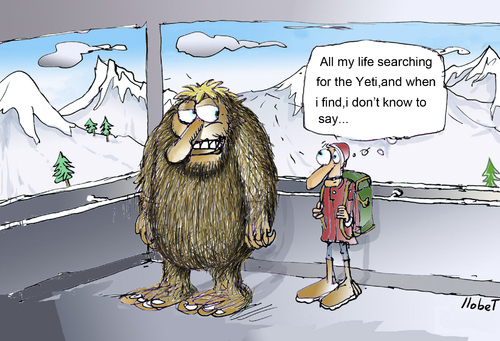 My favorite cartoon this week is “In Search of Yeti” by Spanish artist Llobet. It’s a great combination of two clichés, probably a true observation and a really absurd situation, too. Where does this take place? In a ski-lift? A mountain resort? The Yeti’s home?
My favorite cartoon this week is “In Search of Yeti” by Spanish artist Llobet. It’s a great combination of two clichés, probably a true observation and a really absurd situation, too. Where does this take place? In a ski-lift? A mountain resort? The Yeti’s home?
I have no idea how last week’s Danny-Trejo-caricature fad came into being, but I sure like the outcome. Check out “Warts-and-all Trejo”, “Peyote Trejo“, noseless ‘Trejo Esponja”, and, of course, new user Eno’s very favorable portrait of the Mexican-American actor.
]]>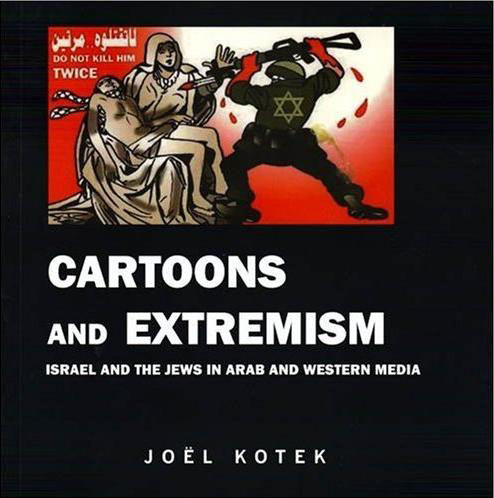 Joël Kotek’s book is based on the observation that there has been a relatively recent (~ 2000) change of quality and amount of cartoons on Israel in Arab media.
Joël Kotek’s book is based on the observation that there has been a relatively recent (~ 2000) change of quality and amount of cartoons on Israel in Arab media.
These cartoons are – as one would guess – aggressively anti-Israel. Moreover, they are blatantly racist, often using images based on century-old anti-Semitic myths, termed “antisemyths” by the author. Since we are living in visual times, these cartoons can be dangerously effective in forming public opinion. The book’s intention is to “deprive [these depictions] of all legitimacy” by exposing them as what they truly are: myths without any foundation in reality.
The first chapter of “Cartoons and Extremism” looks at anti-Semitic myths like infanticide, host desecration and blood libels and traces them back to the 12th and 13th century. Chapter Two deals with the particularities of cartoons in the Muslim world and tells about changes in the depiction of Israel after 1967. The main part of the book, chapter 3, shows recent cartoons using the ancient myths and imagery that hardly differs from anti-Semitic cartoons in Nazi newspaper “Der Stürmer”. The last two chapter then deal with similar imagery in both mainstream European newspapers and leftist anti-globalization platforms and show how Israel is being used as a scapegoat and metaphor for modernity.
The book offers several explanations for the abundance of anti-Semitic imagery. The most prominent one aims at the structural conditions of the Arab media.
Authoritarian structures, says Kotek, prevent many Arab cartoonists from criticizing their own country’s political parties and leaders. Instead, they cut out on the social criticism and humor and deliver heavy, serious and moralizing pieces about an acceptable enemy: Israel and the Jews. These are printed in the majority of the major dailies in the Arab world. Therefore, in the epilogue Kotek sets out to denounce that editorial practice and to “alert the cartoonists of the Arab-Muslim region to a certain sense of responsibility”. In order to do so, he includes twelve theses by the father of peace research, Johan Galtung, pointing out common dangers in reporting on conflict. Some of which, I had the impression don’t really apply to cartooning.
“Cartoons and Extremism” is an interesting book to read, and I fully support its project to sensitize people for anti-Semitic imagery and scapegoating of Israel. It has, however, a couple of flaws that are at times irritating.
First and foremost, its arguments are somewhat weakly supported. Using lengthy quotes from other authors Kotek claims that antisemyths are a symptom of crisis and that anti-Zionism has ” become a means of drowning a feeling of vague guilt on the part of the West”. But he does little to prove this. I understand that the evolution of stereotypical of images in a given culture is a continuous process but since Mr. Kotek claims that there are some crucial dates that marked a change I was sort of waiting for an explanation on how these events changed cartooning. At times, the author’s way of depicting Israel, was leaving out important aspects of the Middle East conflict. I am aware of the danger of ending up saying “Well, it’s their own fault too” when talking about hateful stereotypes. Still, I was a bit annoyed when Mr. Kotek claimed that the scapegoat Israel was really “a defenceless animal”.
The books greatest strength as well as its second big flaw is its use of images.
There are plenty of them, and their number effectively communicates the fact that we are dealing with widely shared stereotypes and not with single cases of tasteless cartoons. On the other hand, I think that Kotek has been overdoing it. There is, for example, simply no point in spending 15 pages in order to show that Brazilian cartoonist Carlos Latuff (a toonpool.com member, by the way) is an anti-Semite. Several pictures are obviously jpegs in awful resolution, some even appear twice in the book. Personally, I could have done without the graphic photos of dead babies, too. The problem with the overabundance of images also ties in with the lack of argument. Some of them have no connection whatsoever with the written text – there’s a whole chapter on the “Strange Case of Greece” that manages to avoid telling what’s so strange about Greece.
In retrospect the book turned out abit disappointing, mostly due to its argumentative weaknesses. Still, I think raising awareness in artists and readers is a very important thing to do and that is something “Cartoons and Extremism” actually can do.
Joël Kotek. Cartoons and Extremism: Israel and the Jews in Arab and Western Media. Edgware, Middlesex: Vallentine Mitchell (2009).
Mr. Kotek, how come so many cartoonists, including both Arabic artists and Western anti-Globalization folks, are insensitive towards connections between their works and what you call “Antisemyths”?
 Strangely enough they do not seems to understand ‘our’ point of view… They consider their work as strictly anti-Israeli and/or anti-zionist. How to explain this ? 1) complete ignorance: actually, they haven’t read my book) 2) hypocritical attitude (they know they produce harsh propaganda but refuse to admit it) 3) worst… they don’t understand our concern because they really share the Stürmer like demonic antisemitism. Personally, this is what I believe. I have no doubt about the fact that radical anti-Semitism is now growing in the Moslem world. My collection of Arab caricatures demonstrates this. The collective image of the Jews created by Arab cartoons lays the groundwork for a possibility of genocide. One can argue about whether these genocidal ideas are conscious or subconscious. My view is that they are still at the subconscious stage.
Strangely enough they do not seems to understand ‘our’ point of view… They consider their work as strictly anti-Israeli and/or anti-zionist. How to explain this ? 1) complete ignorance: actually, they haven’t read my book) 2) hypocritical attitude (they know they produce harsh propaganda but refuse to admit it) 3) worst… they don’t understand our concern because they really share the Stürmer like demonic antisemitism. Personally, this is what I believe. I have no doubt about the fact that radical anti-Semitism is now growing in the Moslem world. My collection of Arab caricatures demonstrates this. The collective image of the Jews created by Arab cartoons lays the groundwork for a possibility of genocide. One can argue about whether these genocidal ideas are conscious or subconscious. My view is that they are still at the subconscious stage.
What, in your opinion, is the connection between anti-Semitism and the common claim of cartoonists that they are merely “anti-Zionists”?
One cannot confuse between “anti-Semitism” and “anti-Zionism”. The argument and thus the graphic code are radically different. Even if I do not share this opinion, “anti-Zionism”, if not radical, is a legitimate opinion. You can be opposed to the idea of a Jewish state – even if it looks strange to me that any people can have a homeland (Kosovars, Palestinians, Kurds, etc.) but not the Jews.
The trouble is that what they believe are anti-Zionist cartoons are outright copies or plagiarisations of images from the Nazi press, foremost “Der Stürmer”. Paradox ally, it is at the very time when, after centuries of obscurantism, Europe discovered the virtue of tolerance, that the Arab-Muslim world united for blatantly expedient reasons to appropriate the stereotype that were hitherto unknown there.
I had the feeling that you were pretty vague about why and when exactly the number of anti-Semitic cartoons increased so greatly. Could you elaborate on that change?
The change came slowly after the 1967 war. Before 1967, the Israeli was just a “dhimmi” that could be very easily exterminated. They were then presented as little devil – the real evil and/or master being the American imperialism. After the 1967 defeat, everything changed since the dhimmi refuse to be exterminated. How could 300,000 million Arabs, one billion Muslims not be able to defeat a country as big as… Corsica ? Logically, the arrived to an phantasmal, but useful, explanation: the Jew as the personification of evil, the real master of the world.
Do you think an appeal towards artists’ and editor’s responsibilities like yours can be effective, when propaganda-style cartoons are a fixed feature of both Arabic newspapers and anti-Globalization websites? Do you know of any voices from within those circles demanding a more differentiated approach and a halt on anti-Semitic imagery?
As far as I know this happen only in Germany. Almost all national indymedia sites publish Carlos Lattuff’s anti-Semitic cartoons. The only one that had the courage to ban them was the German indymedia website.
I suppose one should organize conferences explaining the difference between a political and a racist caricature. What is a (political) caricature ? A criticism and/or an exaggeration of a reality. What is an anti-Semitic cartoon ? A pure invention ! The Israelis do not kill Palestinian children for ritual purposes ! Israelis and Jews are not ugly or evil by nature !
The idea would be to persuade the cartoonists and their bosses that there is a limit not to trespass : racism. In brief, to persuade them to adopt a code of good conduct. Actually this is, more a less, what the French cartoonist Plantu (Le Monde) is trying to organize under the auspices of the UN.
What would you say is the right way to deal with cartoons using anti-Semitic imagery on an international platform for cartoons like toonpool.com?
They should be banned. The limit of the freedom of expression is racism… As their Nazi counterparts, those cartoons are genocidal. They are “ruse de guerre”, “ruse de massacre”, to use the expression of Anthony Julius. Anti-Semitism (and/or racism) is not a opinion but a crime.
Thanks for your time!
]]>
The Middle East Conflict is one of the most frequent topics for cartoons on toonpool.com – and one of the most controversially discussed. I dare say that no other issue has created as much uproar: there have been deletions of cartoons, allegations of anti-Semitism, complaints about censorship and loads of angry comments. One thing I have been missing, however, was actual dialogue.
![]() Ramzy A. Taweel was born in Beirut in 1978 to a Palestinian father and a Lebanese mother. In 1993, shortly after the Oslo Agreement, his family returned to Palestine. Today, Ramzy lives in Ramallah and works as a media officer for the Palestinian president’s office. He is also about to complete his MA thesis in International Studies and he is drawing pretty cool cartoons about everyday life in Palestine. I asked him a couple of questions about life in Ramallah and about relations between “us” and “them”. Which can be read as Israelis and Palestinians, as Jews and Muslims, as men and women or as TV-addicts and fundamentalists, depending on what part of the interview you are reading.
Ramzy A. Taweel was born in Beirut in 1978 to a Palestinian father and a Lebanese mother. In 1993, shortly after the Oslo Agreement, his family returned to Palestine. Today, Ramzy lives in Ramallah and works as a media officer for the Palestinian president’s office. He is also about to complete his MA thesis in International Studies and he is drawing pretty cool cartoons about everyday life in Palestine. I asked him a couple of questions about life in Ramallah and about relations between “us” and “them”. Which can be read as Israelis and Palestinians, as Jews and Muslims, as men and women or as TV-addicts and fundamentalists, depending on what part of the interview you are reading.
Ramzy, can you tell me how you ended up drawing cartoons?
My passion for cartooning officially started in 2002, when I was trying to amuse a beautiful lady at my university. That was when I created my cartoon character Fashcool, a Palestinian college boy who is trying to live a normal life under occupation. The lady is long gone, but Fashcool stayed with me. Moreover, it made me a celebrity at my university and finally at universities all over Palestine.
What limitations do you face in everyday life in Ramallah due to the political situation?
Limitations? … First, I did not travel out of Ramallah from more than five years – since 2001. And Ramallah is a pretty small town. There are too many things happening for the size of this place. I’ve seen death and joy, soldiers and tanks. I’ve seen airplanes bombing houses, soldiers humiliating people and kids crying. I’ve walked through a blizzard together with two thousand other students because the Israeli army had closed the road between my university and Ramallah.
In your cartoons on Palestine, you hardly ever make explicit reference to Israel. Why is that so?
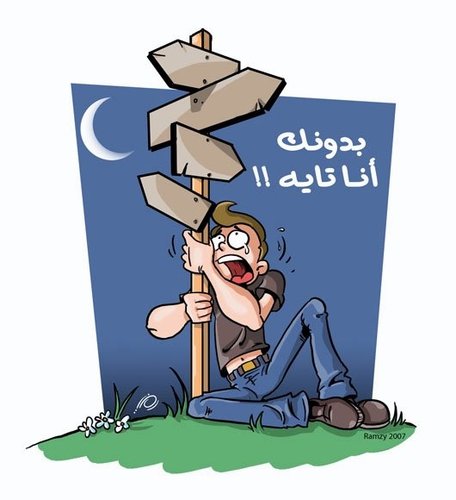 In my cartoons, I try to show my own perspective, not the political situation as a whole. I draw cartoons about every day situations – about love and friendship and about how the occupation affects our lives.
In my cartoons, I try to show my own perspective, not the political situation as a whole. I draw cartoons about every day situations – about love and friendship and about how the occupation affects our lives.
For example, since I am from Ramallah, I couldn’t marry a Palestinian girl from Jerusalem. The whole relation was very stressful and even dangerous for her: Israel might have taken away her ID papers and kicked her out of Jerusalem just because she slept outside the city limits. I drew a lot of cartoons about this situation and about how I lost my love because of it. I also draw about how I am not able to meet my friends because of the wall. All of these are very personal issues. I can’t see them as an abstract political crisis; it’s simply personal pain.
When I draw cartoons, I look for that tiny light that might draw a smile despite the bloody scenery. Young people here have to face multiple problems: their studies, love, work, family and the occupation. Forcing them to smile even at the darkest times is how I fight the occupation.
Is it possible to sum up the position of the Palestinian people toward Israel or are there differences between certain groups?
People are people on either sides. But the problem is not so much between Israelis and Palestinians and it’s definitely not a war of religions. Two plain words: the occupation and the settlements. That’s where the trouble lies. Shortly after the Oslo agreement, Israelis were visiting Ramallah and the other Palestinian cities almost on a daily basis. 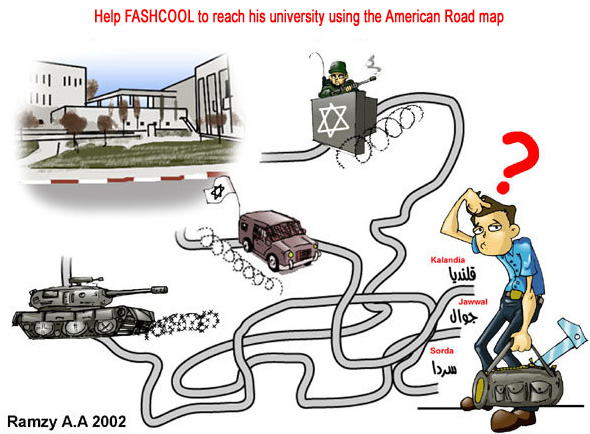 Even today, the economic relations between the West Bank and Israel are more important than the European market. But the settlements eat up Palestinian land and cut off the roads between our cities. Israel even controls over 80 percent of our water supply. They sell our own water back to us.
Even today, the economic relations between the West Bank and Israel are more important than the European market. But the settlements eat up Palestinian land and cut off the roads between our cities. Israel even controls over 80 percent of our water supply. They sell our own water back to us.
But when the Israeli government finally accepts the fact that we must and will have our sacred right of freedom and independence, when they demolish the apartheid wall, you will see how fast wounds can heal.
You say that the West Bank Wall is one important obstacle on the way to peace. What is your reaction to the Israeli argument that the barrier has effectively prevented suicide attacks and thus saved hundreds of lives?
Actually, my problem is not with the wall itself. It’s rather that it was built on our side of the border. On lands inside the 1949 green line which is recognized by the UN as the border of the Palestinian territories.
The wall cuts West Bank into blocks and ghettos with electronic gates between them. For instance, the city of Qalqilyah is completely surrounded by a 9 to12 meter wall. There is a single gate that opens and closes depending on the mood of the Israeli soldiers guarding it.
The wall is a tool to seize more ground from us and to protect settlements. It’s a tool to maintain the occupation, not to protect Israel.
In the past, there have been several cartoons uploaded to toonpool.com that comment on the Palestinian conflict in an aggressive way that is sometimes pretty close to being anti-Semitic…
Paul, if you lived in Palestine for less than one month you might begin to think the same. Yesterday my brother was escorting our dad in an ambulance from Jordan. My dad is dying … and they did not let my brother stay with him. There was no one to hold his hand. Not to mention they forced the doctors to switch ambulances at the border.
I do my best to separate between religion and politics. I almost never use the Star of David. Instead, I use “צה”ל” (“Tzahal”), the acronym for Israel’s military forces. It’s not the Jews but the state of Israel that has committed war crimes against myself and against my people.
As for other cartoonist… You see, I can’t blame them because Israel made it very hard for cartoonists to separate religion from politics.
This question might be a bit naïve: I noticed that most of your characters have a very “western” look. The only reference to a Muslim society I’ve found was that woman wearing a long dress in the background of your “beach” cartoon. What are your reasons for doing it that way?
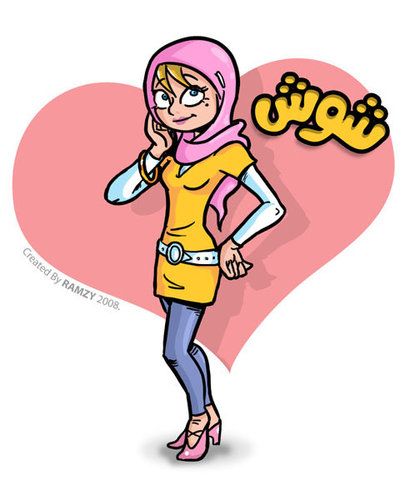 Actually, this is what we are. Palestine is neither Afghanistan nor Saudi Arabia. We are more moderate than you might imagine. Islamic costumes and ways of living only came up in the past 15 years. They are a part of the growth of fundamentalist Islam which has several reasons. There is the failure of development in several Arab countries, for example. And there are some oil states in the Gulf region that actively support extremist views like Wahhabism.
Actually, this is what we are. Palestine is neither Afghanistan nor Saudi Arabia. We are more moderate than you might imagine. Islamic costumes and ways of living only came up in the past 15 years. They are a part of the growth of fundamentalist Islam which has several reasons. There is the failure of development in several Arab countries, for example. And there are some oil states in the Gulf region that actively support extremist views like Wahhabism.
In fact, I’ve drawn several cartoons with females wearing so-called Islamic dresses. But, again, you would be surprised to see what kind of dresses we have here. Women are women anywhere in the world. They will search for beautiful clothes no matter where they live.
As for me, I am a practicing Muslim., but I do live in a global era. You and me, we share values and a way of life. I watched every episode of Saved by the Bell even when I lived in a camp in Jordan. Michael Jackson is my favorite singer and Steve Irwin was my hero. I cried when I heard that he was dead. This is not a Western era anymore, it’s a Global culture with a Western look, don’t you think?
Thanks for your time!
Paul Hellmich
]]>
Max, can you tell me about the cartoons you have removed from toonpool.com so far?
Well, basically we will delete all images that violate our terms of use. This includes, for example, copyright infringements. We have removed a couple of pictures that were using copyrighted characters, e.g. Donald Duck or Warner Brothers characters, without adding some new interpretation.
Another reason for removing cartoons is plagiarism – sometimes artists have obviously stolen somebody else’s ideas. Of course it’s often difficult to determine whether a cartoon has been plagiarized or if people just got the same ideas. Somebody even put up a collection dealing with that matter. A third category would be offensive and discriminating content directed against any group or individual.
Most of the deleted images that raised complaints about censorship were political in nature. Were there any similarities between the ones you removed?
We have been running toonpool.com for almost two years now and there are members from 140 countries representing all major religions. So, when it comes to political cartoons, there are necessarily differing points of view the users will express in their art.
The most outstanding event in this matter were the Israeli attacks on Gaza in January 2009. A lot of the cartoons we received were directed against Israel’s policy. Some of them, however crossed a line. There were some openly anti-Semitic cartoons and others that compared Israel to Nazi Germany, often using swastikas. Those clearly violated our terms of use and have been deleted.
Some users have called this censorship, keeping them from expressing their opinions.
As administrators, we have to set some rules of conduct. There are mainly three reasons for doing so: First of all, toonpool.com is supposed to be a site for an exchange between artists from different cultures. Such exchange is endangered by hateful statements, so we try to keep things peaceful while trying to allow for a maximum range of opinions.
Second, there is a legal dimension. Toonpool.com is hosted in Germany, where as a consequence of our history the use of swastikas and similar symbols is limited by the law and incitement to ethnic or racial hatred is a criminal offense.
Third, the toonpool.com staff feels a responsibility to take a position in these kind of things. As I said, we allow for a maximum range of artistic expression. We try to remain as neutral as possible and keep a lot of cartoons and images that we disagree with. Sometimes we need to act, though. We don’t want our site to be misused for aggressive propaganda.
But people might argue that other comparisons with Hitler or the Nazis are still online, take this caricature of Mahmoud Ahmadinejad, for example.
Basically, we disagree with any comparisons between Nazi Germany and other states. They necessarily distort the system depicted and tend to trivialize the horrors of National Socialism. Still, we kept some of them owing to toonpool.com’s ideal of artistic freedom. Drawing parallels between Israel and the Nazis in our eyes is especially harmful and hateful and will not be tolerated. It doesn’t do anything to explain the Israeli / Palestinian conflict and is a severe insult to the experience of the Jewish people during the 1930s and 1940s.
We are currently rethinking our policy towards Nazi imagery in general, but haven’t come to a decision yet. Concerning the latest incident, I hope that the users will accept our position and respect our terms of use.
I noticed, that you have two ways of dealing with controversial pictures: sometimes you just delete them but in the most recent case you replaced it with a disclaimer and left the comments. What effect do you hope this will have?
Replacing the image was my idea, this was the first time we tried it. Partly, we did it for technical reasons: If somebody posts a link to a picture that has been deleted, its better to have the disclaimer in place of the picture than an error message. On the other hand, we wanted to offer the opportunity to further discuss the topic.
Will you do this with all removed pictures in the future?
We will do this in most cases of cartoons that don’t fall into the copyright violations category. If an artist keeps uploading a picture we deleted, however, we will remove his profile from our site. The new procedure is meant to provide more transparency. I hope that the opportunity to discuss these matters will relieve some tensions.
Thank you for your time!
Paul Hellmich
Image: “Censorship” byAlexei Talimonov
]]>